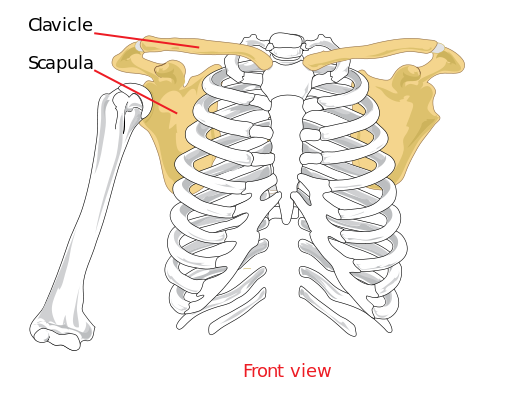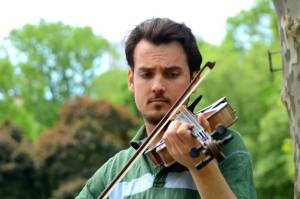 by John Austin
Finding neutral for the shoulders is one of the most challenging things one can do in terms of the use of the self in my experience. Add a complex activity that requires a certain level of ease in the shoulder girdle on top and you’ve got a recipe for paradox and frustration.
by John Austin
Finding neutral for the shoulders is one of the most challenging things one can do in terms of the use of the self in my experience. Add a complex activity that requires a certain level of ease in the shoulder girdle on top and you’ve got a recipe for paradox and frustration.
Let’s begin with the basic anatomy of the shoulder girdle. When I refer to the “shoulder girdle” I mean the hands & arms, shoulder blades, and collar bone. You may be surprised to learn that the only jointed (bone to bone) connection of the shoulder girdle to the rest of the skeleton is in the front of the torso at the top of the sternum.
Find your collar-bone (clavicle) by palpating the bone and follow it toward the mid-line until find two roundish protrusions at either side of the top of chest bone (sternum). You are on top of the sternoclavicular joint(s) where the shoulder girdle meets the rest of the skeleton.
If you follow the collar bone out from the mid-line toward the arm until it reaches the furthest bony protrusion you’ve found the point where the clavicle meets the shoulder blade (scapula), the acromioclavicular joint. It’s called the acromioclavicular joint because it is where the clavicle and the point of the scapula furthest from the mid-line, called the acromion process (processes are protrusions that allow for muscle and ligament attachment), meet. This should not be confused with the glenohumeral joint where the upper arm attaches to the shoulder blade; there is no direct bone to bone attachment of the upper arm to the collarbone.

Now, palpate your way back to toward the mid-line from the acromion, this time following the shoulder blade until it reaches what will feel like the corner of a triangle. You are feeling the “spine” of the scapula. Depending on your muscle build you may have to press quite firmly and the scapula may seemingly disappear into muscle. The strong muscles of the back are what support and stabilize the shoulder girdle as there are no bone to bone attachments in the back. The structure of the shoulder girdle, while providing extreme freedom of movement, also brings an ambiguousness when looking for a neutral position for the shoulders and arms.
It shouldn’t be a surprise that how we use ourselves in our daily activities has a profound effect on the resting lengths of our muscles. It is this phenomenon that we are observing when we see pianists and people who spend hours at the computer still in the shape they work from when walking, eating, watching TV, etc. In the case of the shoulder girdle this can be quite extreme. Because of the lack of bony structural support, the resting position of our shoulders is almost completely determined by the resting lengths of our muscles. If we overstretch our muscles in daily activity, we run the risk of deteriorating the support that allows the shoulders to find a comfortable resting position.
 Along the way to becoming a “serious” violist, I was told to keep my shoulders relaxed. So I went about figuring out how to do that. I am meticulous in the practice room and before long I had discovered that I could relax my left shoulder while playing although my right didn’t really follow suit. The static nature of the left shoulder in violin & viola playing allows for a certain amount of relaxation (release of all/most muscle tone) while the larger more dynamic movements of the bow require the arm muscles which originate in the back to be active for movement to occur. The left shoulder can relax even more if you use a shoulder rest as you then virtually never have to move your shoulder.
Along the way to becoming a “serious” violist, I was told to keep my shoulders relaxed. So I went about figuring out how to do that. I am meticulous in the practice room and before long I had discovered that I could relax my left shoulder while playing although my right didn’t really follow suit. The static nature of the left shoulder in violin & viola playing allows for a certain amount of relaxation (release of all/most muscle tone) while the larger more dynamic movements of the bow require the arm muscles which originate in the back to be active for movement to occur. The left shoulder can relax even more if you use a shoulder rest as you then virtually never have to move your shoulder.
On the surface you’d think that one less thing to worry about (moving the shoulder to balance the instrument) and a little less muscular effort would be good; so for years I ignorantly thought, “I’m raising my right shoulder, that’s not good.” Yet, after hours of playing it was not my right shoulder that cracked and popped, it was my left. Even after years of receiving praise for my tone which of course comes primarily from the bow, I thought, “But my left is down so it must be better than my right,” and went about trying to lower my right. Needless to say I was unsuccessful.
It wasn’t until years of Alexander work that I realized what I was actually doing was relaxing my left shoulder to the point that it was resting on my rib cage. This was the grinding bone on bone I felt in the form of constant cracking and popping when I moved my arm. I was robbing my shoulder girdle of it’s muscular support by relaxing it and then dragging it across my rib cage.
It turns out that the last thing we want to do when doing any activity is rest. The word activity even contains active! To remedy my issue, I had to relearn to play the viola without the shoulder rest. I found that every little shift was a welcome opportunity for movement in my shoulder girdle. Rather than trying to hold myself still or relax into a blob I was free to move and the movement had an organizing effect on my shoulder girdle which helped remind my shoulder blades where neutral was. I had been taught that raising my shoulder was off limits movement-wise on the viola. How ridiculous a notion it was to make a movement off limits when all of the great violinists and even Primrose himself did this subtle lift of the shoulder.
This rule I assume was a reaction to the common problem of violists & violinists clamping down on the instrument between their necks and shoulders, which isn’t much better. Although, too much tension is less likely to destabilize your shoulder girdle. In my case, relaxing has left me not being able to let my left shoulder be in it’s neutral resting place without pain. I’ve over-stretched the muscles and they now rest on bone and nerves. It takes subtle conscious direction of my shoulder for the pain to subside, which is annoying to say the least.
I’m not sure if it is laziness, bad teaching, or what exactly is at the root of the shoulder rest debate in the string playing world. I’ve already written about the laziness possibility here. String teachers having a very small part of the body of knowledge necessary is possible, pun very much intended. It could just come down to the fact that playing the viola is extremely difficult and the shoulder rest is a seductive little crutch that can allow us to avoid having to learn how to properly use our shoulder girdle in the process of playing the viola, which is not simple and takes a long time to do.
Once again the most healthy option seems to be to stop trying to gain our end without reasoning out a means whereby to attain it; not to mention means that at the very least don’t leave us physically and mentally destroyed and/or with a mediocre end: the music which we care so dearly about.
This post originally appeared on John Austin's blog.
[author] [author_image timthumb='on']http://www.acatnyc.org/main/wp-content/uploads/2014/02/headshot.jpg[/author_image] [author_info]JOHN AUSTIN started pondering and pontificating on the probable and possible reasons for the tragic loss of joy in himself and his fellow musicians as he approached his breaking point in a music conservatory. In fact, he was nearly a casualty of the music “busi-ness" when he stumbled on the Alexander Technique. Since then he's been inspired by his training at the American Center for the Alexander Technique to write in an attempt to better understand what was happening to himself and others. Mr. Austin has an active performing career, blog, and teaching studio in West Harlem, Manhattan.[/author_info] [/author]



 by John Austin
Finding neutral for the shoulders is one of the most challenging things one can do in terms of the use of the self in my experience. Add a complex activity that requires a certain level of ease in the shoulder girdle on top and you’ve got a recipe for paradox and frustration.
by John Austin
Finding neutral for the shoulders is one of the most challenging things one can do in terms of the use of the self in my experience. Add a complex activity that requires a certain level of ease in the shoulder girdle on top and you’ve got a recipe for paradox and frustration.
 Along the way to becoming a “serious” violist, I was told to keep my shoulders relaxed. So I went about figuring out how to do that. I am meticulous in the practice room and before long I had discovered that I could relax my left shoulder while playing although my right didn’t really follow suit. The static nature of the left shoulder in violin & viola playing allows for a certain amount of relaxation (release of all/most muscle tone) while the larger more dynamic movements of the bow require the arm muscles which originate in the back to be active for movement to occur. The left shoulder can relax even more if you use a shoulder rest as you then virtually never have to move your shoulder.
Along the way to becoming a “serious” violist, I was told to keep my shoulders relaxed. So I went about figuring out how to do that. I am meticulous in the practice room and before long I had discovered that I could relax my left shoulder while playing although my right didn’t really follow suit. The static nature of the left shoulder in violin & viola playing allows for a certain amount of relaxation (release of all/most muscle tone) while the larger more dynamic movements of the bow require the arm muscles which originate in the back to be active for movement to occur. The left shoulder can relax even more if you use a shoulder rest as you then virtually never have to move your shoulder.